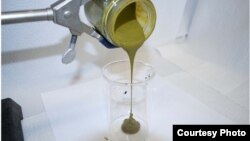It used to take a million years to convert algae to oil, but scientists at the Department of Energy's Pacific Northwest National Laboratory (PNNL), say they have developed a process to do the job in minutes.
In the PNNL process, a slurry of wet algae with the consistency of pea soup is pumped into the front end of a chemical reactor. Once the system is up and running, out comes crude oil in less than an hour, along with water and a byproduct stream of material containing phosphorus that can be recycled to grow more algae.
While algae has long been considered a potential source of biofuel, and several companies have produced algae-based fuels on a research scale, the fuel is projected to be expensive. The PNNL technology harnesses algae's energy potential efficiently and incorporates a number of methods to reduce the cost of producing algae fuel.
"Cost is the big roadblock for algae-based fuel," said Douglas Elliott, the laboratory fellow who led the PNNL team's research. "We believe that the process we've created will help make algae biofuels much more economical."
The most important cost-saving step is that the process works with wet algae. Most current processes require the algae to be dried — a process that takes a lot of energy and is expensive. The new process works with an algae slurry that contains as much as 80 to 90 percent water.
"Not having to dry the algae is a big win in this process; that cuts the cost a great deal," said Elliott. "Then there are bonuses, like being able to extract usable gas from the water and then recycle the remaining water and nutrients to help grow more algae, which further reduces costs."
Other processes for converting algae to oil exist, but according to PNNL, their process can continuously convert 1.5 liters of slurry into biofuel per hour.
They say additionally their process eliminates the need for complex solvents like hexane.
Instead, the PNNL team works with the whole algae, subjecting it to very hot water under high pressure to tear apart the substance, converting most of the biomass into liquid and gas fuels.
The PNNL method requires a lot of heat and a lot of pressure, which together causes what is called hydrothermal liquefaction and catalytic hydrothermal gasification. While not cheap to build, Elliott says the savings “on the back end more than makes up for the investment.”
"It's a bit like using a pressure cooker, only the pressures and temperatures we use are much higher," he said. "In a sense, we are duplicating the process in the Earth that converted algae into oil over the course of millions of years. We're just doing it much, much faster."
A biofuels company, Utah-based Genifuel Corp., has licensed the technology and is working with an industrial partner to build a pilot plant using the technology. The company has been working with Elliott since 2008.
The research results were reported in the journal Algal Research.
Here's a short video about the process:
In the PNNL process, a slurry of wet algae with the consistency of pea soup is pumped into the front end of a chemical reactor. Once the system is up and running, out comes crude oil in less than an hour, along with water and a byproduct stream of material containing phosphorus that can be recycled to grow more algae.
While algae has long been considered a potential source of biofuel, and several companies have produced algae-based fuels on a research scale, the fuel is projected to be expensive. The PNNL technology harnesses algae's energy potential efficiently and incorporates a number of methods to reduce the cost of producing algae fuel.
"Cost is the big roadblock for algae-based fuel," said Douglas Elliott, the laboratory fellow who led the PNNL team's research. "We believe that the process we've created will help make algae biofuels much more economical."
The most important cost-saving step is that the process works with wet algae. Most current processes require the algae to be dried — a process that takes a lot of energy and is expensive. The new process works with an algae slurry that contains as much as 80 to 90 percent water.
"Not having to dry the algae is a big win in this process; that cuts the cost a great deal," said Elliott. "Then there are bonuses, like being able to extract usable gas from the water and then recycle the remaining water and nutrients to help grow more algae, which further reduces costs."
Other processes for converting algae to oil exist, but according to PNNL, their process can continuously convert 1.5 liters of slurry into biofuel per hour.
They say additionally their process eliminates the need for complex solvents like hexane.
Instead, the PNNL team works with the whole algae, subjecting it to very hot water under high pressure to tear apart the substance, converting most of the biomass into liquid and gas fuels.
The PNNL method requires a lot of heat and a lot of pressure, which together causes what is called hydrothermal liquefaction and catalytic hydrothermal gasification. While not cheap to build, Elliott says the savings “on the back end more than makes up for the investment.”
"It's a bit like using a pressure cooker, only the pressures and temperatures we use are much higher," he said. "In a sense, we are duplicating the process in the Earth that converted algae into oil over the course of millions of years. We're just doing it much, much faster."
A biofuels company, Utah-based Genifuel Corp., has licensed the technology and is working with an industrial partner to build a pilot plant using the technology. The company has been working with Elliott since 2008.
The research results were reported in the journal Algal Research.
Here's a short video about the process:









